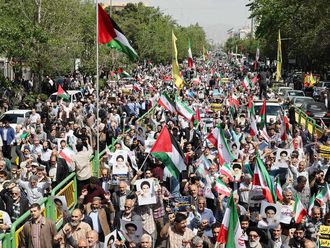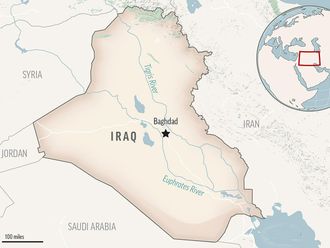Damascus: A battle is brewing between the US-backed forces and Iran-backed troops over who will control a strategic section of the 599km Syrian-Iraqi border. Half of that border is currently in the hands of US-backed Kurdish forces, known as the Syrian Democratic Forces, while the border city of Al Bukamal is under Daesh control. Both camps hope to wrestle Al Bukamal from the clutches of Daesh, and to then march on the oil-rich city of Deir Al Zor, and finally, on to the self-proclaimed capital of Daesh in Raqqa.
But Iranian-backed Shiite militias such as the Iraqi Hashed Shaabi and the Lebanese Hezbollah were deployed on May 6 to grab territory south of Al Bukamal, which is important to Iran as it is the only land route to Syria, Lebanon and ultimately, the Mediterranean Sea.
Despite Russia’s backing of the Syrian government, observers say it does not necessarily see eye to eye with Iran, another backer of President Bashar Al Assad.
“Indeed the US is trying to prevent Iran from having a land route to Damascus. It is not clear, however, that Russia is fully opposed to this. It is something that Washington and Moscow quietly agree upon, as the Russians don’t see eye to eye with Iran on all things nor do they favour the excessive power of Iranian-backed Shiite militias. Russia favours states and their regular armed forces,” Paul Salem, the vice-president of policy and research at Washington-based The Middle East Institute, said.
Since the Syrian-Iraqi operations started in early May, they have grabbed about 1,000 square kilometres in the Syrian Desert, raising red flags in Washington DC.
This is why the New Syrian Army, a US-funded and Jordan-based rebel group, has been deployed to counter these groups.
An attempt to retake Al Bukamal in the summer of 2016 failed after Daesh quickly rounded them up and expelled them.
But this time, they are getting help from Maghaweer Al Thawra Army (Commandos of the Revolution), another US-backed force, currently controlling the desert hills from Al Tanf to the countryside of Deir Al Zor. That area presently includes Humeimeh, a small village strategically located in the countryside of Deir Al Zor, which the Americans hope to use as a spring board for their offensive on Deir Al Zor, located on the shores of the Euphrates.
After Al Bukamal and Deir Al Zor, the US-backed troops plan to create a “shadow buffer” between Deir Al Zor and the ancient city of Homs in the Syrian midland, preventing infiltration by both Daesh and Hezbollah.
If US-backed Syrian rebels capture this territory, this would cut Hezbollah’s lifeline to Iraq via the Damascus-Baghdad Highway, which cuts through the Syrian-Iraqi borders. The US-backed ground operation also aims at creating a buffer zone by Syrian rebels in the Syrian south, along the border with Jordan, similar to the one carved out by Turkey in the north since last August.
It would push the Daesh affiliate of the Syrian south, known as the Khalid Ibn Al Waleed Army, away from Jordanian territory and be used to relocate 1.4 million Syrians living in Jordan since 2011.
“The race for the border highlights an evolving American/Jordanian need to show resolve against a determined Russian/Iranian effort to consolidate supremacy on the ground. The two are on a collision course,” Murhaf Jouejati, a professor of International Relations at the Abu Dhabi-based emirates Diplomatic Academy, told Gulf News.
According to Syrian state media, last Thursday, the US struck at four T-62 tanks and a Soviet-made radar-guided anti-aircraft vehicle in a desert town west of the Syrian-Iraqi frontier town of Al Tanf, killing six Syrian irregular forces. Currently, government troops are approximately 100km outside of Al Tanf, a city recently transformed into a giant military base to train and arm Syrian rebels by the US.
After capturing Al Bukamal, government troops plan to march on Daesh-held Deir Al Zor.
“While most media attention has focused on the battle for Raqqa, the real battle will be for Deir Al Zor. The increased presence of American and British forces in Al Tanf and the training and equipping of the Al Maghaweer Army are yet another indication of the race to take over the Damascus-Baghdad Highway. Trump’s visit to Saudi Arabia and the anti-Iran rhetoric used, especially countering Iran’s role in Syria, and the US strike on Syrian government-affiliated militias near Al Tanf are a final confirmation that all eyes should be on Al Bukamal and the Al Tanf border crossing,” Assaad Al Achi, the executive director of Baytna Syria, told Gulf News.












